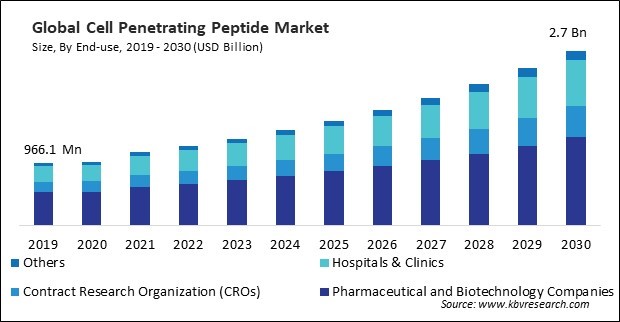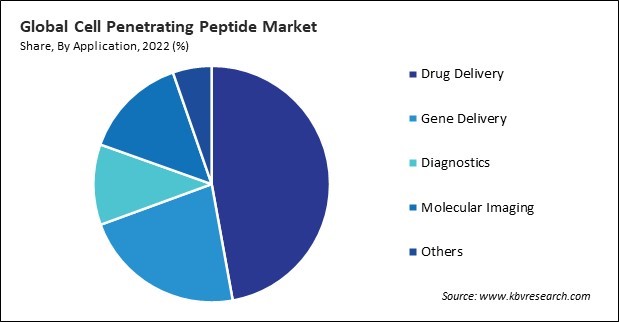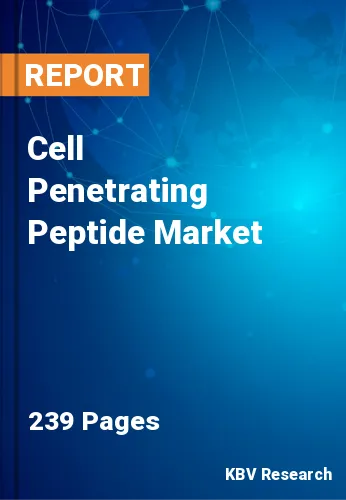“Global Cell Penetrating Peptide Market to reach a market value of USD 2.7 Billion by 2030 growing at a CAGR of 10.5%”
The Global Cell Penetrating Peptide Market size is expected to reach $2.7 billion by 2030, rising at a market growth of 10.5% CAGR during the forecast period.
CPPs offer selectivity in drug delivery, allowing targeted delivery to specific cells or tissues. This targeted approach is advantageous as it minimizes the exposure of healthy cells to therapeutic agents, reducing off-target effects and potential side effects associated with non-specific drug distribution. Consequently, the Chimeric CPPs segment would generate approximately 7.65% share of the market by 2030. CPPs exhibit versatility in delivering various types of therapeutic cargo. They can transport small molecules, peptides, proteins, and nucleic acids, making them suitable for biomedical applications.

Peptide-based therapeutics have gained prominence as a class of drugs with unique properties. They offer specificity in targeting, which can enhance the precision of treatment, and are often associated with lower toxicity and reduced immunogenicity compared to some traditional drugs. This enhanced bioavailability contributes to the overall efficacy of peptide-based therapeutics. These factors will help in the expansion of the market. Moreover, CPPs are crucial in targeted drug delivery, addressing the need for precision in treating chronic diseases. By facilitating the transport of therapeutic agents across cell membranes, CPPs enhance the targeted delivery of drugs to specific cells or tissues affected by chronic conditions. In cancer therapy, CPPs have shown promise in delivering anticancer drugs directly to cancer cells. Thus, these factors will pose lucrative growth prospects for the market.
However, CPPs utilize various cellular uptake mechanisms, including endocytosis, direct translocation, and other pathways. The diversity of mechanisms adds complexity to studying CPP entry into cells. Different CPPs may employ different pathways based on their physicochemical properties, cell type, and other factors. Understanding this diversity is crucial for tailoring CPPs to specific therapeutic applications. Endocytosis, a process where cells engulf extracellular material, is a major pathway for CPP internalization. Therefore, these aspects will reduce demand for cell penetrating peptides in the upcoming years.
Further, the pandemic prompted a significant realignment of research priorities and funding allocations, with a heightened focus on COVID-19-related research and therapeutics. Resources previously directed toward diverse areas, including CPP research, were redirected to address the urgent needs of the pandemic. Many research projects, including those related to CPPs, faced delays due to disruptions in laboratory work, restrictions on physical access to research facilities, and the reprioritization of research efforts. Therefore, the COVID-19 pandemic adversely affected the market.
Based on end-use, the market is divided into pharmaceutical & biotechnology companies, contract research organizations (CROs), hospitals & clinics, and others. The pharmaceutical and biotechnology companies segment recorded the maximum revenue share in the market in 2022. The pharmaceutical and biotechnology sectors increasingly focus on developing targeted therapies to enhance treatment precision and reduce side effects. CPPs play a crucial role in this context by enabling the targeted delivery of therapeutic agents to specific cells or tissues. This targeted approach aligns with the growing trend of personalized medicine, where therapies are tailored to individual patient profiles. As a result, the segment will grow rapidly in the coming years.
On the basis of application, the market is divided into drug delivery, gene delivery, diagnostics, molecular imaging, and others. In 2022, the gene delivery segment witnessed a substantial revenue share in the market. Gene therapy has advanced considerably, with various diseases being treated at the genetic level. CPPs play an important role in gene therapy by acting as carriers for therapeutic genes. By transferring functional or therapeutic genes into target cells, this technique shows promise for treating genetic diseases, malignancies, and other ailments. These factors will assist in the expansion of the segment.

Based on type, the market is segmented into protein derived CPPs, synthetic CPPs, and chimeric CPPs. The synthetic CPPs segment held the largest revenue share in the market in 2022. Synthetic CPPs often exhibit enhanced stability compared to natural CPPs. The synthetic design allows for incorporating modifications that improve resistance to enzymatic degradation and enhance overall stability in physiological conditions. This increased stability contributes to improved bioavailability and sustained therapeutic effects, addressing challenges associated with the rapid degradation of peptides. These factors will boost the demand in the segment.
Free Valuable Insights: Global Cell Penetrating Peptide Market size to reach USD 2.7 Billion by 2030
By region, the market is segmented into North America, Europe, Asia Pacific, and LAMEA. In 2022, the Europe segment acquired a considerable revenue share in the market. Europe has witnessed increased investments in biotechnology, which includes areas such as drug development and delivery technologies. The cell-penetrating peptide market has likely benefited from these investments, leading to advancements in research and the potential commercialization of CPP-based products. These aspects will fuel the expansion of the segment.
| Report Attribute | Details |
|---|---|
| Market size value in 2022 | USD 1.2 Billion |
| Market size forecast in 2030 | USD 2.7 Billion |
| Base Year | 2022 |
| Historical Period | 2019 to 2021 |
| Forecast Period | 2023 to 2030 |
| Revenue Growth Rate | CAGR of 10.5% from 2023 to 2030 |
| Number of Pages | 239 |
| Number of Tables | 380 |
| Report coverage | Market Trends, Revenue Estimation and Forecast, Segmentation Analysis, Regional and Country Breakdown, Porter’s 5 Forces Analysis, Company Profiling, Companies Strategic Developments, SWOT Analysis, Winning Imperatives |
| Segments covered | Type, Application, End-use, Region |
| Country scope |
|
| Companies Included | Biosynth Ltd, Creative Peptides, Cupid Peptide Company Limited, Alta Bioscience Ltd, AnaSpec Inc. (Kaneka Eurogentec S.A.) (Kaneka Corporation), Peptomyc SL, PolyPeptide Group AG, Bachem Holding AG (Ingro Finanz AG), Sarepta Therapeutics, Inc., Revance Therapeutics, Inc. |
By End-use
By Application
By Type
By Geography
The Market size is projected to reach USD $2.7 billion by 2030.
Increased focus on peptide therapeutics are driving the Market in coming years, however, Limited understanding of mechanisms restraints the growth of the Market.
Biosynth Ltd, Creative Peptides, Cupid Peptide Company Limited, Alta Bioscience Ltd, AnaSpec Inc. (Kaneka Eurogentec S.A.) (Kaneka Corporation), Peptomyc SL, PolyPeptide Group AG, Bachem Holding AG (Ingro Finanz AG), Sarepta Therapeutics, Inc., Revance Therapeutics, Inc.
The expected CAGR of this Market is 10.5% from 2023 to 2030.
The Drug Delivery segment is leading the Market, by Application in 2022 thereby, achieving a market value of $1.2 Billion by 2030.
The North America region dominated the Market, by region in 2022 thereby, achieving a market value of $1.3 Billion by 2030, growing at a CAGR of 9.6 % during the forecast period.
Our team of dedicated experts can provide you with attractive expansion opportunities for your business.

 Drivers
Drivers
 Restraints
Restraints
